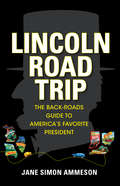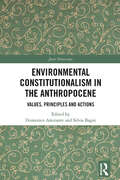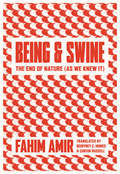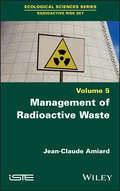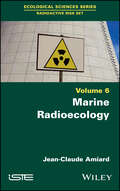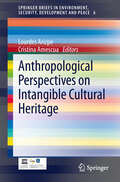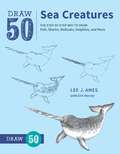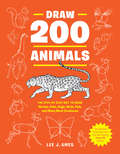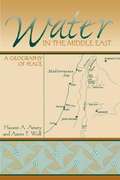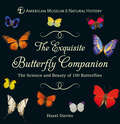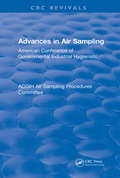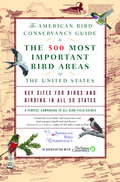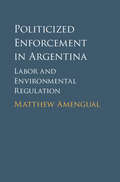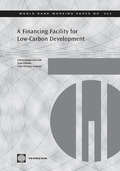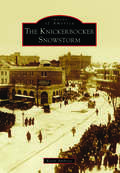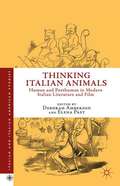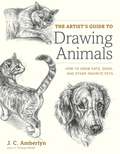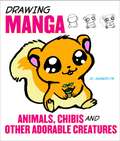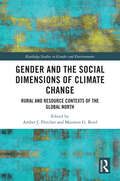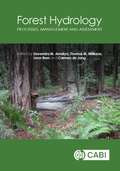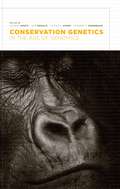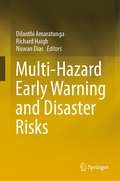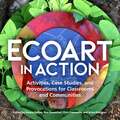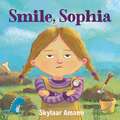- Table View
- List View
Lincoln Road Trip: The Back-Roads Guide to America’s Favorite President
by Jane Simon AmmesonAmerica's favorite president sure got around. From his time as a child in Kentucky, as a lawyer in Illinois, and all the way to the Oval Office, Abraham Lincoln toured across the countryside and cities and stayed at some amazing locations. In Lincoln Road Trip: The Back-Roads Guide to America's Favorite President, Jane Simon Ammeson will help you step back into history by visiting the sites where Abe lived and visited. This fun and entertaining travel guide includes the stories behind the quintessential Lincoln sites, but also takes you off the beaten path to fascinating and lesser-known historical places. Visit the Log Inn in Warrenton, Indiana (now the oldest restaurant in the state), which opened in 1825 and where Lincoln stayed in 1844, when he was campaigning for Henry Clay. You can also visit key places in Lincoln's life, like the home of merchant Colonel Jones, who allowed a young Abe to read all his books, or Ward's Academy, where Mary Todd Lincoln attended school. Along with both famous and overlooked places with Lincoln connections, Jane Simon Ammeson profiles nearby attractions to round out your trip, like Holiday World & Splashin' Safari, a third-generation family-owned amusement park that can be partnered with a trip to the Lincoln Boyhood National Memorial and Lincoln State Park. Featuring new and exciting Lincoln tales from Springfield, IL; Beardstown, KY; Booneville, IN; Alton, IL; and many more, Lincoln Road Trip is a fun adventure through America's heartland that will bring Lincoln's incredible story to life.
Environmental Constitutionalism in the Anthropocene: Values, Principles and Actions (Juris Diversitas)
by Domenico Amirante Silvia BagniThis book examines the relationship between man and nature through different cultural approaches to encourage new environmental legislation as a means of fostering acceptance at a local level. In 2019, the International Union of Geological Sciences (IUGS) recognised that we have entered a new era, the Anthropocene, specifically characterised by the impact of one species, mankind, on environmental change. The Anthropocene is penetrating the discourse of both hard sciences and humanities and social sciences, by posing new epistemological as well as practical challenges to many disciplines. Legal sciences have so far been at the margins of this intellectual renewal, with few contributions on the central role that the notion of Anthropocene could play in forging a more effective and just environmental law. By applying a multidisciplinary approach and adopting a Law as Culture paradigm to the study of law, this book explores new paths of investigation and possible solutions to be applied. New perspectives for the constitutional framing of environmental policies, rights, and alternative methods for bottom-up participatory law-making and conflict resolution are investigated, showing that environmental justice is not just an option, but an objective within reach. The book will be essential reading for students, academics, and policymakers in the areas of law, environmental studies and anthropology.
Being and Swine: The End of Nature (As We Knew It)
by Fahim AmirForget everything you think you know about nature. Fahim Amir’s award-winning book takes pure delight in posing unexpected questions: Are animals victims of human domination, or heroes of resistance? Is nature pristine and defenceless, or sentient and devious? Is being human really a prerequisite for being political? In a world where birds on Viagra punch above their weight and termites hijack the heating systems of major cities, animals can be recast as vigilantes, agitators, and public enemies in their own right. Under Amir’s magic spell, pigs transform from slaughterhouse innocents into rioting revolutionaries, pigeons from urban pests into unruly militants, honeybees from virtuous fuzzballs into shameless centrefold models for eco-capitalism. As paws, claws, talons, and hooves seize the means of production, Being and Swine spirals higher and higher into a heady thesis that becomes more convincing by the minute. At the heart of Amir’s writing is a deep optimism and bracingly fresh reading of Marxist, post-colonial, and feminist theory, building upon the radical scholarship of Donna J. Haraway and others. Contrarian, whip-smart, and wildly innovative, no other book will laugh at your convictions quite like this one.
Management of Radioactive Waste
by Jean-Claude AmiardThe classification of radioactive waste varies from state to state. This results in different management procedures for each country, while following IAEA and OECD/NEA recommendations.Radioactive waste comes from numerous sources. The largest volumes are generated by the decommissioning and dismantling of nuclear facilities. Long-lived, medium- and high-activity waste – categorized as the most hazardous types of waste – are in fact largely produced by nuclear power reactors, spent fuel reprocessing plants and nuclear accidents.Final disposal of very low-activity, low-activity and very short-lived waste is well controlled. However, final solutions for certain categories, including long-lived waste, sorted waste and spent graphite waste, are not yet in place.Management of Radioactive Waste reviews all the possible solutions and presents those chosen by the various states, including a chapter detailing policy on radioactive waste management, taking France as an example.
Anthropological Perspectives on Intangible Cultural Heritage (SpringerBriefs in Environment, Security, Development and Peace #6)
by Cristina Amescua Lourdes ArizpeA decade after the approval of the UNESCO 2003 Convention for the Safeguarding of Intangible Cultural Heritage (ICH), the concept has gained wide acceptance at the local, national and international levels. Communities are recognizing and celebrating their Intangible Heritage; governments are devoting important efforts to the construction of national inventories; and anthropologists and professionals from different disciplines are forming a new field of study. The ten chapters of this book include the peer-reviewed papers of the First Planning Meeting of the International Social Science Council's Commission on Research on ICH, which was held at the Centro Regional de Investigaciones Multidisciplinarias (UNAM) in Cuernavaca, Mexico in 2012. The papers are based on fieldwork and direct involvement in assessing and reconceptualizing the outcomes of the UNESCO Convention. The report in Appendix 1 highlights the main points raised during the sessions.
Draw 50 Sea Creatures: The Step-by-Step Way to Draw Fish, Sharks, Mollusks, Dolphins, and More
by Lee J. Ames Erin HarveyPart of the best-selling Draw 50 series this step-by-step guide to drawing various fish, sharks, oysters, bottlenose dolphins, crabs, polar bears, coral, and other ocean life is for artists of all levels.In this new installment of Lee J. Ames's beloved Draw 50 series, readers will find easy-to-follow, step-by-step visual lessons on sketching and rendering all kinds of sea and ocean-dwelling creatures. Animals and plants from in and near the water featured in the book include clownfish, whale sharks, sea otters, dolphins, turtles and more.
Draw 200 Animals: The Step-by-Step Way to Draw Horses, Cats, Dogs, Birds, Fish, and Many More Creatures
by Lee J. AmesA compendium of step-by-step drawing exercises from the best-selling Draw 50 series that features easy-to-follow lessons for rendering animals including cats, dogs, horses, prehistoric creatures, and more.With exercises taken from the animal drawing instruction titles in Lee J. Ames's beloved Draw 50 series, Draw 200 Animals brings you the best of Draw 50 Animals, Draw 50 Cats, Draw 50 Dogs, Draw 50 Horses, and Draw 50 Dinosaurs and Other Prehistoric Animals in a must-have collection of easy-to-follow, step-by-step visual lessons on sketching and rendering all kinds of furry, feathered, and finned critters. These classic lessons show you how to draw everything from pets to wild animals, including birds, insects, elephants, tigers, and more, in styles ranging from realistic to cartoony.
Water in the Middle East: A Geography of Peace
by Hussein A. Amery Aaron T. WolfFinding "streams in the desert" has never been more urgent for the peoples of the Middle East. Rapid population growth and a rising standard of living are driving water demand inexorably upward, while the natural supply has not increased since Biblical times. Ensuring a fair and adequate distribution of water in the region is vitally important for building a lasting peace among the nations of the Middle East.
The Exquisite Butterfly Companion: The Science and Beauty of 100 Butterflies
by American Museum of Natural History Hazel DaviesAn informative and gorgeously illustrated field guide for butterfly enthusiasts everywhere!Butterflies and moths have fascinated people for centuries. Their bright colors, varied wing shapes, and endless patterns capture the imagination, making them the stuff of myth and folklore. Today, butterfly watching—or “butterflying”—has become a popular hobby with numerous clubs and festivals devoted to it.In The Exquisite Butterfly Companion, Hazel Davis of the American Museum of Natural History presents an engaging introduction to these fascinating insects. An opening chapter discusses butterfly and moth basics, such as their taxonomy, life cycle, migration, and more. Then follows a lushly illustrated catalogue of butterfly and moth species, offering detailed information on their unique colorings and habitats.
Advances In Air Sampling: American Conference of Governmental Industrial Hygienists (CRC Press Revivals)
by American Conference of Governmental Industrial HygienistsA copublication of the American Conference of Governmental Industrial Hygienists and Lewis Publishers, this series continues the former Annuals of the American Conference of Governmental Industrial Hygienists. This series is designed to present state-of-the-art information on research and practical applications of science in the field of occupational health. Bokos are normally the proceedings of an important symposium or conference sponsored by the ACGIH or other leading professional organization in, or allied with, the occupational health field. Content deals with subject of current interest. Books in the Industrial Hygiene Science Series should become valued additions to the international scientific literature. Published volumes in this series are: Microcomputer Applications in Occupational Health and Safety Ergonomic Interventions to Prevent Musculoskeletal Injuries in Industry Advances in Air Sampling.
The American Bird Conservancy Guide to the 500 Most Important Bird Areas in the United States
by American Bird ConservancyThe American Bird Conservancy Guide to the 500 Most Important Bird Areas in the United States offers both bird enthusiasts and conservationists specialized information never before compiled in a single comprehensive volume. This expert resource organizes the United States into 36 ornithologically distinct bird regions, then identifies and describes the 500 sites within these regions. Each site entry includes ornithological highlights, ownership information, a description of habitats and land use, a guide to which species one can expect to find, conservation issues, and visitor information. Full-color maps and illustrations throughout, along with a thorough index, make this book as useful as it is unique, an essential addition to the bird lover’s library.
Politicized Enforcement in Argentina
by Matthew AmengualCountries throughout the world have passed regulations that promise protection for workers and the environment, but violations of these policies are more common than compliance. All too often, limitations of state capacity and political will intertwine hindering enforcement. Why do states enforce regulations in some places, and in some industries, but not in others? In Politicized Enforcement in Argentina, Amengual develops a framework for analyzing enforcement in middle-income and developing countries, showing how informal linkages between state officials and groups within society allow officials to gain the operational resources and political support necessary for enforcement. This analysis builds on state-society approaches in comparative politics, but in contrast to theories that emphasize state autonomy, it focuses on key differences in the way states are porous to political influence.
A Financing Facility for Low-Carbon Development in Developing Countries
by Philippe Ambrosi Ivan ZelenkoThis paper proposes an innovative financing mechanism, known as the Low Carbon Development Facility (LCDF) that would bring additional investment financing at concessional rates to unlock low carbon development projects in non-Annex 1 countries, increasing project-based emissions avoidance in these countries. The LCDF could be a modality of the Copenhagen Green Climate Fund to implement the financial pledges made by Annex 1 countries as a result of Copenhagen and post-COP15 negotiations to support projects, programs, policies and/or other activities in developing countries related to NAMAs. LCDF will not substitute the Global Environment Facility (GEF) and the Clean Technology Fund (CTF) and would rather support the innovative projects pioneered by these instruments.
Knickerbocker Snowstorm, The (Images of America)
by Kevin AmbroseOn the evening of January 28, 1922, several hundred people fought their way through the greatest snowstorm in Washington's history to see a show at the Knickerbocker Theater, the city's largest and most modern moving picture theater of the time. Unbeknownst to the theater patrons, the Knickerbocker Theater's flat roof was tremendously burdened by the weight of the snow. During the show's intermission, the snow-covered roof crashed down upon the crowd. As the roof fell, it collapsed the theater's balcony and pulled down portions of the surrounding brick walls, killing 98 people and injuring 133. Some of Washington's prominent politicians and business owners were among the casualties. The disaster ranks as one of Washington's worst in history, and the snowstorm continues to hold the record for Washington's single greatest snowfall.
The Anasazi: Prehistoric People of the Four Corners Region
by J. Richard AmblerAmbler explores the Four Corners of Colorado, Utah, Arizona and New Mexico. Weaving together its geological, ecological and human histories, he presents a unique portrait of this ruggedly beautiful landscape that goes beyond mere description to give readers a true sense of the land in all its richness. Here are rock croppings that are 2 billion years old and broad desert valleys where rivers of lava cooled to form floors of solid rock. Here ancient hunter-gatherers stalked the woolly mammoth, four-story pueblos were carved by the Anasazi from sheer stone cliffs and an ancient midnight Holy Week ceremony is still practiced in a modern Spanish village. Providing a fresh perspective on a region currently enjoying an upwelling of interest, Four Corners is a study of one of the world's great wonders -- compelling reading for all science, nature, anthropology and travel aficionados.
Thinking Italian Animals
by Deborah Amberson Elena PastSituated on the cutting edge of scholarship in a variety of fields, this bracing volume draws together essays on Italian writers and filmmakers whose work engages with nonhuman animal subjectivity. Analyzing works from unification to the present, they address three major strands of current philosophical thought: the perceived borders between man and nonhuman animals, historical and fictional crises facing humanity, and human entanglement with the nonhuman and material world. These essays are driven by philosophical, theoretical, and ethical questions that interrogate Italian cultural production in provocative new ways, and their analysis has implications not simply for Italianists, but for a range of scholars doing work within cross-disciplinary fields such as animal studies, ecocriticism, and posthuman philosophy.
The Artist's Guide to Drawing Animals: How to Draw Cats, Dogs, and Other Favorite Pets
by J. C. AmberlynCreate Classic Portraits of Favorite PetsThe Artist's Guide to Drawing Animals continues the rich tradition of animals in art. In this step-by-step guide to rendering your favorite animals in pencil and pen-and-ink, J. C. Amberlyn combines her love of pets and other familiar domestic creatures with her beautiful, detailed drawing style. Covering a variety of animals from beloved pets like dogs and cats to barnyard critters like cows and sheep and many more, the book covers every species with easy-to-follow instructions for drawing them from every angle imaginable. Along with seven featured examinations of Amberlyn's artistic process, each chapter showcases the tools and techniques needed to produce your own highly detailed, lifelike drawings of a variety of well-known animal companions. The worlds of artists and animal lovers come together in this richly illustrated, in-depth guide to producing charming portraits of some of the most popular pets and domesticated creatures.Also available as an eBookFrom the Trade Paperback edition.
Drawing Manga Animals, Chibis, and Other Adorable Creatures
by J. C. AmberlynLearn the Tricks of the Trade for Drawing Irresistibly Cute Manga-Style Animals and Chibis! The world of manga is filled with strange creatures and adorable sidekicks. Just about every manga hero and heroine has an animal mascot, and all the most popular ones have a cute "chibi" form. This book teaches aspiring manga artists how to create the funny critters that populate girls' manga and the more gritty, gothic creatures found in boys' manga. It starts with the basics of creating manga-style characters--everything from drawing heads and faces to eyes and expressions, to creating incredibly cute chibis. Part two features a valuable reference section on the mythological and real animals that have shaped Japanese artwork and stories. The final section has step-by-step demonstrations on using computer programs such as Photoshop and Corel Painter to create manga art and comics. So whether you're just starting out and want to draw a cute, simple mascot, or would like to try something more complex like an Asian dragon, or are ready to create your own otherworldly adventure, this book has something for you no matter what your skill level.From the Trade Paperback edition.
Gender and the Social Dimensions of Climate Change: Rural and Resource Contexts of the Global North (Routledge Studies in Gender and Environments)
by Amber J. Fletcher and Maureen G. ReedDispelling the myth that people in the Global North share similar experiences of climate change, this book reveals how intersecting social dimensions of climate change—people, processes, and institutions—give rise to different experiences of loss, adaptation, and resilience among those living in rural and resource contexts of the Global North. Bringing together leading feminist researchers and practitioners from three countries—Australia, Canada, and Spain—this collection documents gender relations in fossil fuel, mining, and extractive industries, in land-based livelihoods, in approaches for inclusive environmental policy, and in the lived experience of climate hazards. Uniquely, the book brings together the voices, expertise, and experiences of both academic researchers and women whose views have not been prioritized in formal policies—for example, women in agriculture, Indigenous women, immigrant women, and women in male-dominated professions. Their contributions are insightful and compelling, highlighting the significance of gaining diverse perspectives for a fuller understanding of climate change impacts, more equitable processes and strategies for climate change adaptation, and a more welcoming climate future. This book will be vital reading for students and scholars of gender studies, environmental studies, environmental sociology, geography, and sustainability science. It will provide important insights for planners, decision makers, and community advocates to strengthen their understanding of social dimensions of climate change and to develop more inclusive and equitable adaptation policies, plans, and practices.
Forest Hydrology
by Devendra M. Amatya Thomas M. Williams Leon Bren Carmen JongForests cover approximately 26% of the world's land surface area and represent a distinct biotic community. They interact with water and soil in a variety of ways, providing canopy surfaces which trap precipitation and allow evaporation back into the atmosphere, thus regulating how much water reaches the forest floor as through fall, as well as pull water from the soil for transpiration. The discipline "forest hydrology" has been developed throughout the 20th century. During that time human intervention in natural landscapes has increased, and land use and management practices have intensified. This book: - Presents cutting edge thinking and assessments in forest hydrology across all latitudes and terrains, including state-of-the-art modelling techniques and methodologies - Describes the latest challenges facing forest hydrology, such as increased occurrence of disturbance, due to extreme floods, drought, disease, and fire, potentially caused by climate change - Is written by an internationally renowned team of scientists, engineers, and managers to give a well-rounded review of the subject The book will be useful for graduate students, professionals, land managers, practitioners, and researchers with a good understanding of the basic principles of hydrology and hydrologic processes.
Conservation Genetics in the Age of Genomics (American Museum of Natural History, Center for Biodiversity Conservation, Series on Biodiversity)
by Amato George Rob DeSalle Oliver A. Ryder Howard C. Rosenbaum Eds.Genome sequencing enables scientists to study genes over time and to test the genetic variability of any form of life, from bacteria to mammals. Thanks to advances in molecular genetics, scientists can now determine an animal's degree of inbreeding or compare genetic variation of a captive species to wild or natural populations. Mapping an organism's genetic makeup recasts such terms as biodiversity and species and enables the conservation of rare or threatened species, populations, and genes. By introducing a new paradigm for studying and preserving life at a variety of levels, genomics offers solutions to previously intractable problems in understanding the biology of complex organisms and creates new tools for preserving the patterns and processes of life on this planet. Featuring a number of high-profile researchers, this volume introduces the use of molecular genetics in conservation biology and provides a historical perspective on the opportunities and challenges presented by new technologies. It discusses zoo-, museum-, and herbarium-based biological collections, which have expanded over the past decade, and covers the promises and problems of genomic and reproductive technology. The collection concludes with the philosophical and legal issues of conservation genetics and their potential effects on public policy.
Multi-Hazard Early Warning and Disaster Risks
by Dilanthi Amaratunga Richard Haigh Nuwan DiasThis book presents a collection of papers under the theme of multi-hazard early warning and disaster risks. These were selected from the presentations made at the International Symposium on Tsunami and Multi-Hazard Risks, Early Warning and Community Awareness in supporting implementation of the Sendai Framework for Disaster Risk Reduction 2015-2030. This conference aimed to recognize achievements and to highlight work that still needs to be carried out. The conference promoted collaboration among academia, research institutions and disaster management offices, and further encouraged multidisciplinary and multi-sectoral interactionThis International Symposium on Multi-Hazard Early Warning and Disaster Risk Reduction provided an important opportunity to reflect upon our progress to date in tackling disaster risk, but also to consider some of the challenges and opportunities that lay ahead of us.A particular focus of this event wasMulti-Hazard Early Warning. During the negotiations for the Sendai Framework, countries and partners highlighted the need to:1. Continue to invest in, develop, maintain and strengthen people-centred, end-to-end early warning systems;2. Promote the application of simple and low cost early warning equipment and facilities;3. Broaden the dissemination channels for early warning information to facilitate early action.Countries also called for the further development of and investment in effective, nationally compatible, regional multi-hazard early warning mechanisms. To address these needs, global Target (g) of the Sendai Framework was adopted, namely to “substantially increase the availability of and access to multi-hazard early warning systems and disaster risk information and assessments to the people by 2030”. As illustrated by recent events in Indonesia, it is also vital to address the challenge of cascading hazards that pose a tsunami risk, and the importance of linking tsunami early warning to a multi-hazard environment. However, moving towards a multi-hazard environment is complex and poses many challenges but can bring significant benefits in terms of efficiencies and also in recognising the links between hazards, such as cascading threats. We very much hope that this book will provide an important platform to address these and other challenges in addressing disaster risk, as well as supporting implementation of the Sendai Framework for Disaster Risk Reduction
Ecoart in Action: Activities, Case Studies, and Provocations for Classrooms and Communities
by Amara Geffen, Ann Rosenthal, Chris Fremantle, and Aviva RahmaniReady-to-go, vetted approaches for facilitating artistic environmental projectsHow do we educate those who feel an urgency to address our environmental and social challenges? What ethical concerns do art-makers face who are committed to a deep green agenda? How can we refocus education to emphasize integrative thinking and inspire hope? What role might art play in actualizing environmental resilience?Compiled from 67 members of the Ecoart Network, a group of more than 200 internationally established practitioners, Ecoart in Action stands as a field guide that offers practical solutions to critical environmental challenges. Organized into three sections—Activities, Case Studies, and Provocations—each contribution provides models for ecoart practice that are adaptable for use within a variety of classrooms, communities, and contexts. Educators developing project and place-based learning curricula, citizens, policymakers, scientists, land managers, and those who work with communities (human and other) will find inspiration for integrating art, science, and community-engaged practices into on-the-ground environmental projects. If you share a concern for the environmental crisis and believe art can provide new options, this book is for you!
Smile, Sophia
by Skylaar AmannIn Smile, Sophia, a smart, relatable picture book by author/illustrator Skylaar Amann, a serious dino-loving little girl just doesn't feel like smiling...and that's okay.Sophia loves finding fossils and digging up dinosaur bones. But she doesn’t love the way all the grownups just want her to smile. What does smiling have to do with the very serious business of being a scientist?! She’ll smile when she has something to smile about! In this picture book by Skylaar Amann, a young girl shows that being strong, and smart, and really good at what she does is more than enough—and if she smiles, it’s because she wants to!
